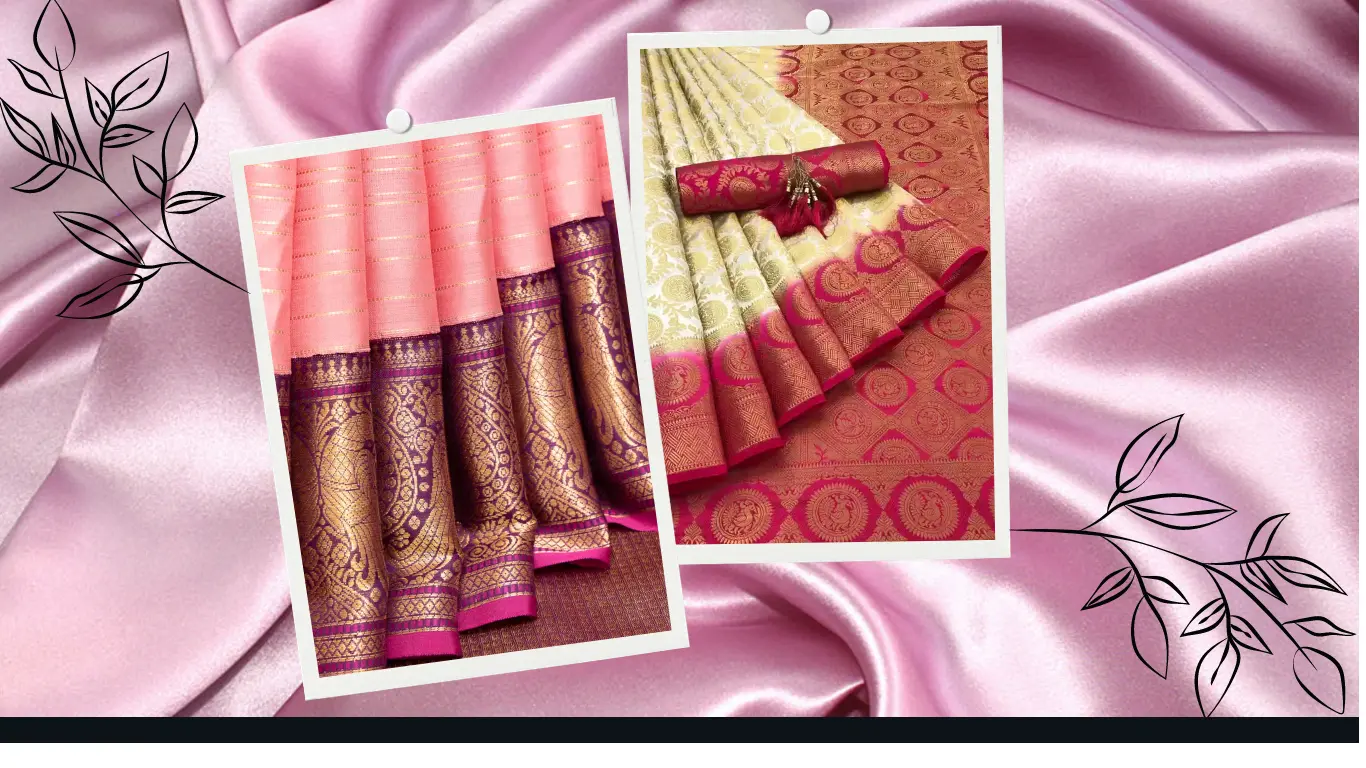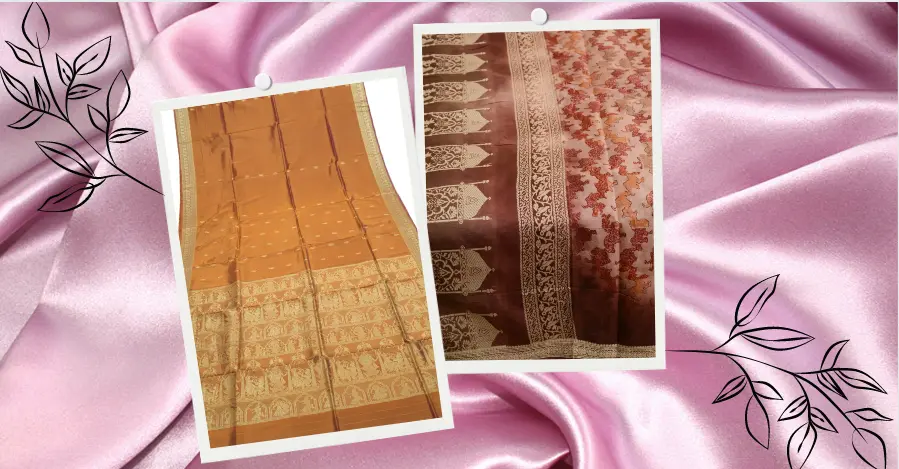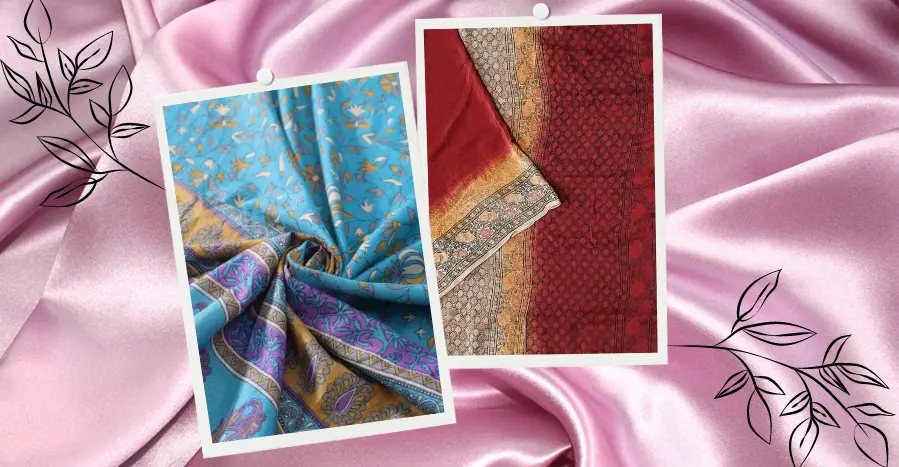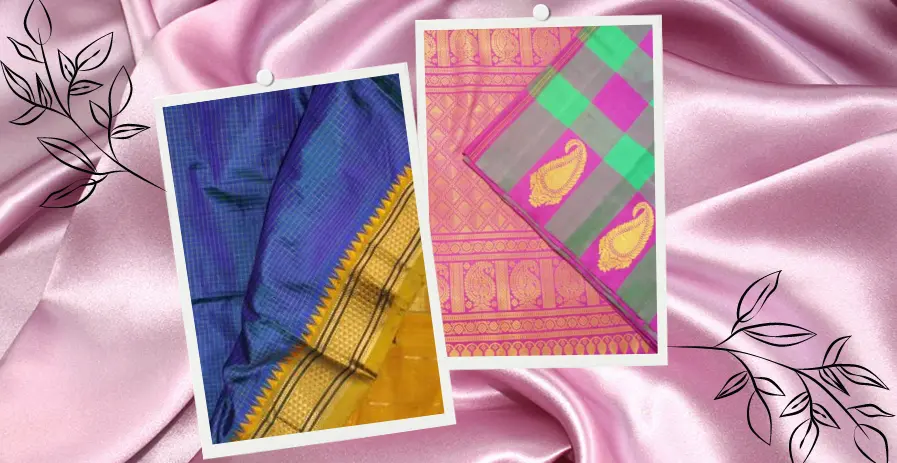TYPES OF SILK SAREES

Come! Let’s dive into the world of beautiful types of silk sarees! These special Indian outfits come in all sorts, each with its own unique look and style. From different regions and with various patterns, silk sarees are a colorful celebration of tradition and charm.
List of Silk Sarees
- Kanchipuram Silk Saree
- Banarasi Silk Saree
- Kanjeevaram Silk Saree
- Patola Silk Saree
- Mysore Silk Saree
- Tussar Silk Saree
- Bhagalpuri Silk Saree
- Assam Silk Saree (Muga Silk)
- Baluchari Silk Saree
- Chanderi Silk Saree
- Paithani Silk Saree
- Uppada Silk Saree
- Kota Silk Saree
- Gadwal Silk Saree
- Soft Silk Saree
- Jamdani Silk Saree
- Kantha Silk Saree
- Murshidabad Silk Saree
- Sambalpuri Silk Saree
- Bomkai Silk Saree
- Kanchi Cotton Silk Saree
- Pochampally Silk Saree
- Crepe Silk Saree
- Venkatagiri Silk Saree
- Konrad Silk Saree (Temple Saree)
- Chettinad Silk Saree
- Mulberry Silk Saree
- Ilkal Silk Saree
- Kosa Silk Saree
- Kota Doria Silk Saree
- Raw Silk Saree
Kanchipuram Silk Saree

The Kanchipuram silk saree, renowned for its unparalleled craftsmanship and luxurious quality, is a traditional handwoven silk saree originating from the town of Kanchipuram in Tamil Nadu, India.
Often referred to as the “Queen of Silks,” these sarees are distinguished by their exquisite silk fabric, vibrant colors, and intricate zari work, which involves the use of fine gold or silver threads.
The history of Kanchipuram silk dates back to the ancient Chola dynasty, and the weaving techniques have been passed down through generations.
The sarees are characterized by their wide contrast borders and pallus, featuring traditional motifs inspired by temples, nature, and mythology.
Kanchipuram silk sarees are a symbol of cultural richness and are highly sought after for bridal wear and special occasions, both within India and internationally, showcasing the enduring elegance of South Indian textile artistry.
Banarasi Silk Saree

Banarasi silk sarees are a hallmark of Indian traditional weaving and craftsmanship, renowned for their opulence, intricate designs, and luxurious silk fabric. Originating from Varanasi, also known as Benares, in Uttar Pradesh, India, these sarees have a history dating back several centuries.
The weaving of Banarasi silk is often associated with Mughal influence, and the sarees are characterized by their fine silk threads, elaborate zari work (metallic thread embroidery), and rich brocade patterns.
Fun fact: The art of weaving silk sarees is so intricate that a traditional Banarasi saree can take about 15 days to six months to complete, depending on its complexity and the craftsmanship involved.
The sarees typically feature ornate designs such as floral motifs, intricate paisleys, and detailed geometrical shapes. Banarasi silk sarees are highly prized for their elegance and are considered a symbol of Indian cultural heritage.
They are often favored as bridal attire and are worn during special occasions, festivals, and weddings. The meticulous craftsmanship and timeless beauty of Banarasi silk sarees have earned them a special place in the world of traditional Indian textiles and continue to be cherished by women across the country and beyond.
Kanjeevaram Silk Saree

Kanjeevaram, also known as Kanchipuram, silk sarees are a celebrated traditional textile from the town of Kanchipuram in Tamil Nadu, India. Revered for their exceptional craftsmanship and luxurious silk, Kanjeevaram sarees hold a special place in South Indian culture and are often considered one of the finest types of silk sarees in India.
These sarees are woven using pure mulberry silk threads and are distinguished by their bold and vibrant colors, wide contrast borders, and intricate zari work, which involves the use of gold and silver threads.
Kanjeevaram sarees are characterized by their durability and heavy silk, making them ideal for weddings and other festive occasions. The designs often feature traditional motifs inspired by temples, nature, and mythology, and the sarees are known for their durability and ability to retain their sheen over time.
Kanjeevaram silk sarees are highly sought after for bridal wear and are cherished as heirlooms, passed down through generations as a symbol of tradition and timeless elegance.
Patola Silk Saree

Patola silk sarees, originating from Gujarat, India, are prized for their unique double ikat weaving technique, creating symmetrical patterns on both warp and weft threads.
Characterized by vibrant colors and intricate motifs, these reversible sarees are worn during special occasions like weddings and festivals. Patola silk sarees are a symbol of status, showcasing the rich craftsmanship and cultural heritage of the region.
Mysore Silk Saree

Mysore silk sarees are exquisite traditional silk sarees that hail from the city of Mysuru (Mysore) in the state of Karnataka, India. Known for their soft texture, lightweight feel, and vibrant colors, these sarees are woven with pure silk and often adorned with intricate zari work.
Mysore silk is recognized for its natural sheen and durability. The sarees typically feature elegant designs, floral motifs, and contrasting borders. Mysore silk sarees are popular choices for various occasions, including weddings, festivals, and formal events.
They reflect the rich weaving heritage of Mysuru and continue to be cherished for their timeless beauty and comfort.
Tussar Silk Saree

Tussar silk sarees, originating from Bihar, Jharkhand, and West Bengal in India, are prized for their distinctive texture and natural golden sheen. Woven from the cocoons of wild Tussar silkworms, these sarees exhibit a unique coarse quality.
Adorned with traditional hand-painted or block-printed designs, Tussar silk sarees come in earthy tones and are known for their lightweight and breathable nature.
Popular for both casual and formal occasions, these sarees reflect a blend of traditional craftsmanship and a natural, rustic charm, making them a favored choice among those who appreciate distinctive textiles.
Bhagalpuri Silk Saree

Bhagalpuri silk sarees, also known as Tussar silk sarees from Bhagalpur, Bihar, are celebrated for their fine texture and natural elegance. Woven from Tussar silk, these sarees are characterized by a rich, golden sheen and a unique, slightly coarse feel.
Bhagalpuri silk sarees often feature traditional motifs and intricate designs, showcasing the craftsmanship of the weavers.
The lightweight and breathable nature of Tussar silk makes Bhagalpuri sarees versatile for various occasions, from casual to formal. Renowned for their aesthetic appeal and cultural significance, Bhagalpuri silk sarees capture the essence of traditional weaving, making them a popular choice among those who appreciate the beauty of authentic silk textiles.
Assam Silk Saree (Muga Silk)

Assam silk sarees, particularly those made from Muga silk, originate from the northeastern state of Assam, India. Muga silk is exclusive to Assam and is renowned for its natural golden hue and durability.
These sarees are handwoven by skilled artisans, showcasing intricate motifs inspired by Assamese culture, nature, and traditional designs. Muga silk sarees are prized for their lustrous texture and ability to retain their sheen over time.
The fabric is also known for its strength and resilience. These sarees are often worn during special occasions, festivals, and weddings, symbolizing cultural heritage and the craftsmanship of the region. The unique qualities of Muga silk and the artistic craftsmanship make Assam silk sarees a cherished representation of Assamese tradition and elegance.
Baluchari Silk Saree

Baluchari silk sarees originate from Baluchar in West Bengal, India, and are known for their intricate depictions of mythological scenes woven into fine silk threads. Highlighted by elaborate pallus, these sarees feature vibrant colors and showcase themes from epics like the Ramayana.
Admired for special occasions, Baluchari silk sarees are prized for their meticulous craftsmanship and cultural storytelling.
Chanderi Silk Saree

Chanderi silk sarees are traditional Indian sarees originating from the town of Chanderi in Madhya Pradesh. Known for their sheer texture, lightweight feel, and luxurious silk blend, Chanderi silk sarees are characterized by their fine zari work and delicate embroidery. The sarees often feature traditional motifs like peacocks, flowers, and geometric patterns.
Chanderi silk is woven with a mix of silk and cotton, creating a unique texture that is both elegant and comfortable. These sarees are popular for both formal and casual occasions, reflecting the timeless charm of Chanderi weaving and the cultural richness of Indian textiles.
Paithani Silk Saree

Paithani silk sarees are traditional handwoven sarees originating from the town of Paithan in Maharashtra, India. Known for their vibrant colors, fine silk, and elaborate zari work, Paithani sarees are characterized by a peacock and flower motif on the pallu (decorative end-piece).
The distinctive feature of these sarees is the use of pure silk and real zari, creating a luxurious and rich texture.
Paithani silk sarees are often worn on special occasions, weddings, and festivals, symbolizing cultural heritage and exquisite craftsmanship. The intricate interplay of colors and the precision of weaving make Paithani silk sarees highly valued and sought after for their artistic and traditional significance.
Uppada Silk Saree

Uppada silk sarees are traditional handwoven sarees from the town of Uppada in the East Godavari district of Andhra Pradesh, India. Renowned for their lightweight and finely woven texture, Uppada silk sarees often feature intricate zari work and strikingly vivid colors.
These sarees are woven using the Jamdani technique, where small decorative motifs are added during the weaving process, creating a unique and elegant design.
Uppada silk sarees are favored for their graceful drape and are often chosen for festive occasions, weddings, and cultural events. The combination of quality silk and meticulous craftsmanship makes Uppada silk sarees a symbol of traditional Indian artistry and a cherished choice for special celebrations.
Kota Silk Saree

Kota silk sarees are traditional handwoven sarees that originate from the town of Kota in Rajasthan, India. Known for their lightweight and airy texture, these sarees are typically woven in a square-check pattern, also known as “khat.”
Kota silk sarees are made from pure silk or a blend of silk and cotton, making them comfortable and suitable for various climates.
The distinctive square-check pattern adds a subtle elegance to the saree. These sarees often feature zari borders and pallus, enhancing their overall appeal.
Kota silk sarees are favored for casual and formal wear, and their understated beauty and comfort make them popular choices for everyday use as well as special occasions.
Gadwal Silk Saree

Gadwal silk sarees are traditional handwoven sarees that hail from the town of Gadwal in the state of Telangana, India. Known for their unique weaving technique, Gadwal sarees typically have a silk body with a cotton border and pallu (decorative end-piece).
The distinguishing feature is the “Kuttu” border, which is a combination of silk and zari, providing a striking contrast to the rest of the saree.
Gadwal silk sarees often showcase vibrant colors, intricate patterns, and zari work. These sarees are celebrated for their lightweight feel and are popular choices for festive occasions, weddings, and cultural events.
The combination of silk and cotton makes Gadwal sarees comfortable and versatile, reflecting the rich weaving heritage of the region.
Soft Silk Saree

Soft silk sarees, often referred to as pure silk sarees, are a luxurious and elegant category of sarees known for their smooth and lustrous texture. These sarees are typically made from pure silk fibers, and their quality is characterized by the fineness and softness of the silk.
Soft silk sarees come in various regional varieties, each with its own unique weaving techniques, designs, and cultural significance.
Soft silk sarees are popular choices for special occasions, weddings, and celebrations due to their graceful drape and luxurious appearance. The use of high-quality silk in the weaving process contributes to the soft and silky feel of the fabric, making these sarees comfortable to wear while exuding sophistication and charm.
The beauty of soft silk sarees lies in their timeless appeal and the craftsmanship involved in creating these exquisite pieces of traditional attire.
Jamdani Silk Saree

Jamdani silk sarees, originating from Bangladesh, are renowned for their intricate floral and geometric motifs created through the Jamdani weaving technique. This traditional method involves adding supplementary weft threads, resulting in a lightweight and airy fabric with delicate patterns.
Jamdani silk sarees, appreciated for their sheer texture and artistic craftsmanship, are suitable for various occasions, embodying the rich cultural heritage of the region.
Kantha Silk Saree

Kantha silk sarees, belonging to the vibrant array of types of silk sarees, are characterized by their unique embroidery technique known as Kantha. Originating from West Bengal, India, Kantha involves intricate hand-stitched patterns that adorn the fabric, creating a distinct and artistic appeal.
Kantha silk sarees are typically crafted from soft silk or cotton, and the embroidery often depicts floral, animal, or geometric designs. These sarees are celebrated for their lightweight feel, vibrant colors, and the cultural significance of the Kantha stitching tradition.
Often worn casually, Kantha silk sarees showcase the fusion of traditional craftsmanship and contemporary elegance.
Murshidabad Silk Saree

Murshidabad silk sarees, belonging to the diverse category of types of silk sarees, originate from the historic city of Murshidabad in West Bengal, India. Known for their rich heritage and exquisite craftsmanship, these sarees are woven from pure silk and often feature intricate zari work.
Murshidabad silk sarees showcase elegant designs inspired by nature, traditional motifs, and cultural influences. Renowned for their luxurious texture and vibrant colors, these sarees are favored for special occasions and celebrations.
The distinctive weaving style and cultural significance make Murshidabad silk sarees a cherished choice among the various types of silk sarees available in India.
Sambalpuri Silk Saree

Sambalpuri silk sarees, a distinguished member of the diverse category of types of silk sarees, hail from the Sambalpur region in Odisha, India. Known for their unique ikat weaving technique, these sarees showcase vibrant and intricate tie-and-dye patterns.
Sambalpuri silk sarees often feature traditional motifs like shankha (conch shell), chakra (wheel), and phula (flower), reflecting the cultural identity of the region.
The exceptional craftsmanship and vivid colors make these sarees popular for festive occasions and cultural events. As a prominent representative of types of silk sarees, Sambalpuri silk sarees stand out for their artistic weaving and cultural significance, embodying the rich textile heritage of Odisha.
Bomkai Silk Saree

Bomkai silk sarees, categorized among the diverse array of types of silk sarees, are traditional handwoven sarees originating from the Bomkai region in Odisha, India.
Known for their distinctive design elements, these sarees often feature contrasting borders, intricate threadwork, and supplementary warp threads that create a unique texture.
Bomkai silk sarees are celebrated for their vibrant colors and traditional motifs like flowers, animals, and tribal art. As a cherished representative among types of silk sarees, Bomkai silk sarees showcase the skilled craftsmanship and cultural richness of Odisha’s textile heritage, making them a sought-after choice for various festive and cultural occasions.
Kanchi Cotton Silk Saree

Kanchi cotton silk sarees, falling within the diverse category of types of silk sarees, are traditional handwoven sarees originating from Kanchipuram (Kanchi) in Tamil Nadu, India. These sarees are crafted from a blend of silk and cotton, combining the lustrous appeal of silk with the comfort of cotton.
Kanchi cotton silk sarees feature intricate zari work and vibrant colors, often adorned with traditional motifs inspired by temples and nature.
As an esteemed member among types of silk sarees, Kanchi cotton silk sarees showcase the weaving excellence of Kanchipuram and are favored for their graceful drape, making them suitable for both formal and casual occasions.
Pochampally Silk Saree

Pochampally silk sarees, among the distinguished types of silk sarees, originate from the town of Pochampally in Telangana, India. Known for their unique tie-and-dye or “Ikat” weaving technique, these sarees feature vibrant geometric patterns. Pochampally silk sarees are characterized by their lightweight texture and are woven from pure silk or silk-cotton blends.
As a notable representative of types of silk sarees, Pochampally silk sarees showcase intricate craftsmanship and bold designs, often in contrasting colors. These sarees are popular choices for festive occasions and cultural celebrations, exemplifying the rich weaving tradition of Pochampally and contributing to the diverse tapestry of types of silk sarees in India.
Crepe silk saree

Crepe silk sarees, falling under the diverse category of types of silk sarees, are known for their elegant and luxurious drape. These sarees are crafted from crepe silk, a fabric with a slightly crinkled texture, which adds to its distinctive appeal.
Crepe silk sarees are celebrated for their smooth and flowing nature, making them ideal for various occasions, from formal events to festive celebrations.
As a noteworthy member among types of silk sarees, crepe silk sarees often feature subtle sheen and are available in a wide range of colors and designs.
The lightweight and graceful quality of crepe silk make these sarees a popular choice, contributing to the varied collection of types of silk sarees available in the Indian textile landscape.
Venkatagiri Silk Saree

Venkatagiri silk sarees, belonging to the diverse category of types of silk sarees, are traditional handwoven sarees from the town of Venkatagiri in Andhra Pradesh, India. These sarees are known for their fine silk fabric, intricate zari work, and a lightweight feel.
Venkatagiri silk sarees often feature rich brocade patterns and are adorned with traditional motifs inspired by nature and mythology.
As a significant representative among types of silk sarees, Venkatagiri silk sarees are favored for their elegant appearance and are suitable for various occasions, including weddings and cultural events.
The skilled craftsmanship and cultural heritage embedded in Venkatagiri silk sarees contribute to their esteemed status among the diverse array of types of silk sarees in India.Top of Form
Konrad Silk Saree (Temple Saree)

The Konrad Silk Saree, also known as the Temple Saree, is a traditional South Indian silk saree that holds a significant place among the diverse types of silk sarees. Originating from the state of Tamil Nadu, these sarees are characterized by their exquisite silk fabric and distinctive zari work.
What sets the Konrad Silk Saree apart is its intricate motifs inspired by temple art and architecture, making it a unique and culturally rich choice for special occasions and ceremonies.
The saree is often adorned with traditional patterns like elephants, peacocks, and floral designs, reflecting the cultural heritage of South India. Renowned for their timeless beauty and craftsmanship, Konrad Silk Sarees are cherished for their role in celebrating both tradition and elegance in the realm of saree varieties.
Chettinad Silk Saree

The Chettinad Silk Saree stands out as a distinctive member among the myriad types of silk sarees, hailing from the Chettinad region in Tamil Nadu, India. Renowned for its rich and bold color palette, these sarees are woven with fine silk threads and often feature striking checks, stripes, and vibrant borders.
What sets the Chettinad Silk Saree apart is its unique weaving technique, where contrasting colors and intricate patterns are skillfully incorporated into the fabric.
These sarees are also characterized by their broad borders adorned with traditional motifs, reflecting the cultural heritage of the Chettinad region. Known for their durability and luxurious appeal, Chettinad Silk Sarees are a popular choice for weddings and festive occasions, symbolizing the perfect blend of tradition and contemporary elegance.
Mulberry silk saree

The Mulberry Silk Saree is a testament to elegance and luxury among the diverse types of silk sarees. Crafted from the finest silk produced by silkworms exclusively fed with mulberry leaves, these sarees are celebrated for their smooth texture, natural sheen, and lightweight drape.
Originating from regions like Karnataka and Tamil Nadu, Mulberry Silk Sarees are prized for their impeccable craftsmanship and intricate zari work, often featuring elaborate designs that add a touch of sophistication.
The sheerness and inherent luster of mulberry silk make these sarees a popular choice for formal occasions and celebrations, symbolizing timeless beauty and the epitome of fine silk weaving in the rich tapestry of Indian traditional attire.
Ilkal Silk Saree

Ilkal Silk sarees are traditional handwoven garments originating from the town of Ilkal in the Bagalkot district of Karnataka, India. Renowned for their vibrant colors and unique weaving technique, Ilkal sarees typically feature a distinctive pallu, a portion of the saree that is woven separately and then attached.
The body of the saree is adorned with intricate geometric patterns, and the pallu is often characterized by vibrant stripes and contrasting colors. Ilkal Silk sarees hold cultural significance and are often worn during auspicious occasions and festivals, making them a cherished part of Karnataka’s textile heritage.
Kosa Silk Saree

Kosa Silk sarees, on the other hand, hail from the state of Chhattisgarh in central India and are celebrated for their luxurious texture and natural sheen. These sarees are crafted from Kosa silk, which is produced by silkworms that feed on Saja or Arjun trees.
Known for their lightweight and breathable nature, Kosa Silk sarees are favored for their elegant drape and comfort.
The sarees often feature intricate zari work and traditional motifs that showcase the skilled craftsmanship of the weavers. Kosa Silk sarees are a testament to the rich cultural tapestry of Chhattisgarh, reflecting the artistry and heritage of the region.
Kota Doria Silk Saree

The Kota Doria Silk Saree is a masterpiece that combines the finesse of silk with the delicate Kota Doria weaving technique. Originating from the town of Kota in Rajasthan, India, these sarees are celebrated for their sheer texture and lightweight feel.
The distinctive square-like patterns, known as khats, are woven using a combination of cotton and silk threads, creating a unique and breathable fabric.
The use of silk adds a touch of luxury and sheen to the saree, making it an ideal choice for both casual and festive occasions. Kota Doria Silk Sarees often feature intricate zari borders and pallus, showcasing the skilled craftsmanship of the weavers.
With their elegant appeal and comfort, these sarees stand as a testament to the timeless charm of traditional Indian handloom textiles.
Raw Silk Saree

The Raw Silk Saree is a timeless classic in the realm of traditional Indian attire, prized for its natural texture and luxurious appeal. Made from unprocessed silk fibers, raw silk retains its natural irregularities, giving the fabric a unique, coarse texture.
These sarees are known for their rich, subtle sheen and are often favored for both casual and formal occasions.
Raw Silk Sarees come in a myriad of colors, and their versatility allows them to be adorned with intricate embroidery, zari work, or other embellishments.
Whether in solid hues or adorned with traditional motifs, these sarees exude an understated elegance that captures the essence of sophistication, making them a popular choice for various cultural celebrations and events. Top of Form
Read more: What is Peau de soie fabric?
Which type of silk sarees is best?
The best type of silk saree depends on personal preferences and occasions. Some popular choices include Banarasi, Kanjeevaram, and Baluchari for their exquisite craftsmanship and rich cultural heritage.
Which one types of silk sarees is costly?
Among silk sarees, Kanchipuram (Kanjeevaram) silk sarees are often considered the costliest due to their intricate weaving, use of pure silk, and vibrant zari work, making them a symbol of luxury.
Is silk saree easy to wear?
While silk sarees are known for their elegance, wearing the sarees might require some practice due to their intricate draping style. However, with practice, it becomes easier, and the result is a stunning and graceful look.
Conclusion: Types of Slik Sarees
To sum up, types of silk sarees like Banarasi, Kanjeevaram, and Mysore silk represent India’s rich culture. They are special because of their unique designs and how they are made. These sarees are a beautiful and timeless part of Indian tradition. However, the choice depends on individual preferences.






